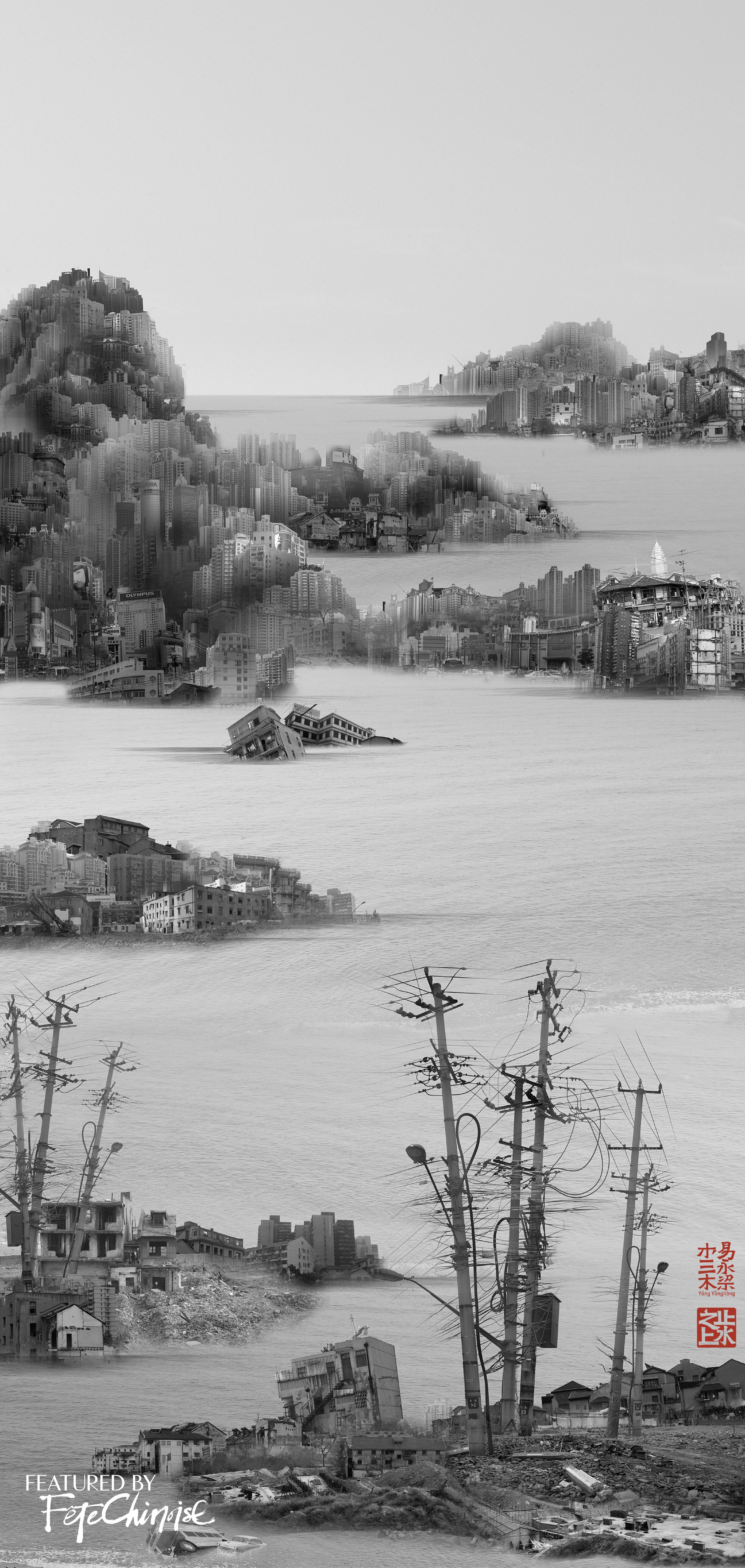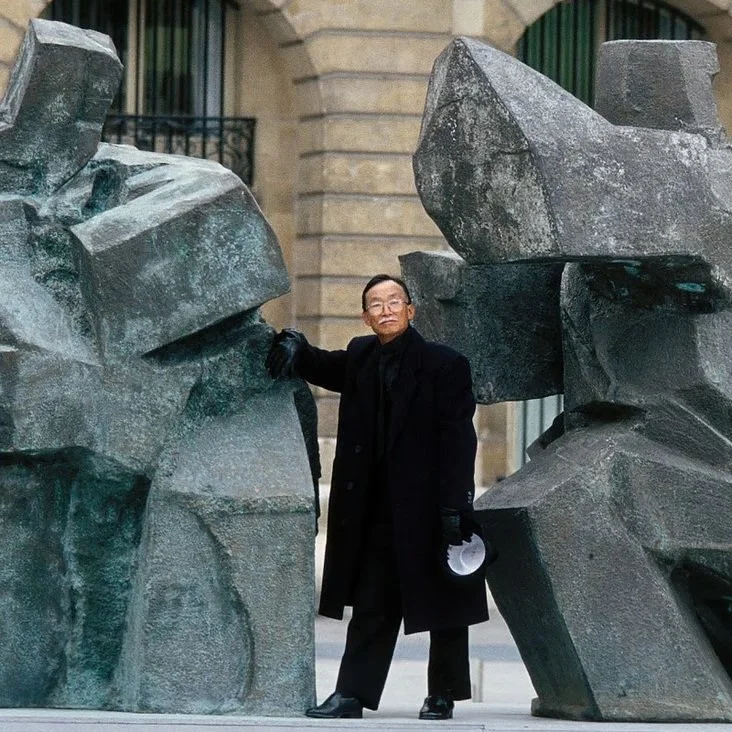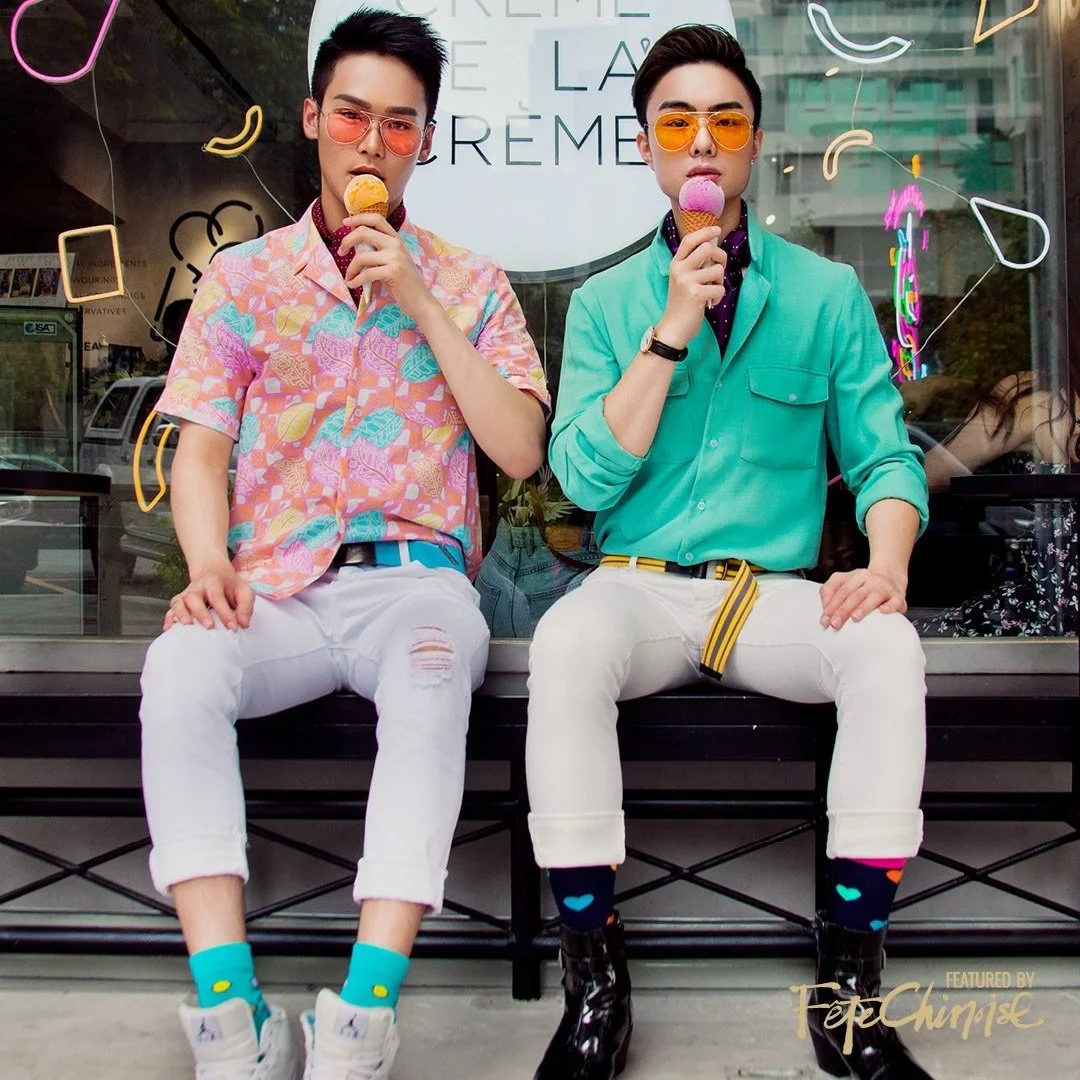Contemporary Artist Yang Yongliang Reimagines Chinese Landscape Art with Virtual Reality 楊泳梁的山水影像實驗
Written by Yang Yongliang
Translated by Xiarui Xie
Edited by Fête Chinoise Team
VR : 《Journey to the Dark II 夜游記二》
Video installation | 12 × 70 m | 12600 × 2160 px | 9’50’’ | 2019
On the Quiet Water Ruins in the Water 水上廢墟
I began studying Chinese traditional painting and calligraphy since the age of 10. My favourite Chinese artists include Fan Kuan, Li Cheng, Ma Yuan among many others. I would describe myself as a landscape painter who is interested in depicting mindscapes of various mediums. My “dreamscape” is an artificial wonderland that is intriguing while simultaneously being horrifying. I would say I am the most visually inspired in Iceland.
One of my first multi-channel 4k video works is entitled “Journey to the Dark.” It unveils a surrealistic urban night scene that merges into an infinite galaxy; the artificial and the natural converges by the skyline, and they co-exist in a peculiar harmony. Along with a technical upgrade onto 3-channel 4K, the two-dimensional video achieves a tremendous scale that allows an immersive visual experience for the viewer. I used images of architecture as brushstrokes; heavy mountain rocks with enriched details draw a faithful reference to Song Dynasty landscape painting.
As for my biggest accomplishments, I believe I am the first to bring Chinese landscape art into the world of virtual reality. My most memorable piece is entitled “Fall into Oblivion” (2015). I remember this because it was truly a conscious decision to step out of my own comfort zone and work collaboratively with other people on this particular project. And this collaboration piqued my appetite for more.
In 10 years, I see myself doing the same kinds of works that I have been working on over the past decade. Except for one thing. I will be doing it with a team and completing projects on a larger scale. I desire to establish a more mature language of immersive storytelling in the near future as well. Ultimately, I hope that the world will look at my work and feel connected to it.
“Generally speaking, there’s a gap between the history of Asian art versus contemporary Asian art that I would love for someone else to close. It’d be lovely to see more contemporary works that connect to the Asian descent.”
On the Quiet Water Ruins in the Water 水上廢墟
以城市建築影像為筆觸,宋代層巒疊嶂的山水風格為藍本,數位影像譜寫厚重又蘊藏著豐富細節的山岩 —- 這就是楊泳梁的《攝影山水》。城市發展正在滋養都會的繁華,同時錮來了生活上的束縛;中國上千年的山水畫文化傳統博大精深,因其悠久、深邃,而被固有的思想侷限,也呆濟沉悶。古人用山水畫來讚美大自然的偉大;而楊泳梁著意透過他的山喚起人們對當今社會現狀的探搜和反思。
從10歲起,楊泳梁便開始學習中國傳統書畫,他最喜歡的中國藝術家包括範寬、李成和馬遠等。他將自己定位為一位善於描繪多種媒介的思維模式的山水畫家。
楊泳梁從冰島獲得了創作靈感,他的「夢景」是一個令人著迷又令人恐懼的人造仙境 — 他一直關注高速發展的經濟和城市化所帶來的環境與社會問題,對發達工業化和地區生態造成的破壞性後果提出質疑。他的作品乍看是優美的山水風景,但當走進細節才發現是衰敗的現代城市,充斥著各種人造的工業符號。宋代繪畫中的樹木枯枝被金屬板、電線桿替代,由摩天大樓組成的山巒正在受到洪水的威脅。楊泳梁巧妙地暗示了傳統與現代、自然和人文間的微妙對話和平衡。
《夜遊記二》是他的第一批創作三屏的4K影像數位作品。楊泳梁用城市建築的影像作為畫筆,峰巒疊嶂地譜寫出一幅以宋代山水繪畫風格為藍本的數碼影像創作——一幅超現實主義的城市夜景,城市在夜晚融入無限的星系,人造和自然景觀在天際線上融合,並以一種奇特的和諧感共存著一個超現實主義畫面中。三屏4K技術的升級允許巨大規模的二維視頻為這幅作品,實現了身臨其境的視覺體驗。伴隨著陰森恐怖的聲效,在長達70米,規模更為宏大的《夜遊記二》中,觀眾可以蜿蜒穿越一座陌生的山區城市。
當被問及他最大的成就時,楊泳梁認為,他將中國山水畫融入了虛擬現實的世界 — 在此之前還沒有人有過這樣大膽的嘗試。
他2015年的作品《陌入止境》則是他最具紀念意義的作品。他回憶道:在這個項目中與其他人合作,走出了自己的舒適區。通過這次合作,楊泳梁開始更加期待與他人一同創作。
未來的10年,他認為自己會繼續致力於過去十年中未完成的事業,創造更多類似的數位山水作品。不同的是,他將與不同團隊一起進行規模更大的創作。他希望在不久的將來建立一種更成熟的語言來表達更動人的故事。最後,楊泳梁希望世界看到他的作品並產生共鳴。
About the Artist, Yang Yongliang 楊泳梁
Born in Shanghai in 1980, Yang was trained as a pupil of traditional Chinese art since early childhood. he graduated from China Academy of Art in Shanghai in 2003, majoring in Visual Communication. Yang explores connections between traditional art and the contemporary, implementing ancient oriental aesthetics and literati beliefs with modern language and digital techniques. His work has been exhibited internationally at museums and biennials, such as Thessaloniki Biennale in Greece (2009), Ullens Center for Contemporary Art in Beijing (2012), National Gallery of Victoria in Melbourne (2012), Moscow Biennale (2013), Metropolitan Museum of Art New York (2013), Daegu Photo Biennale in Korea (2014); and has been collected by more than 20 public institutes including the British Museum, Brooklyn Museum, the Metropolitan Museum of Art in New York, Museum of Fine Arts Boston, and San Francisco Asian Art Museum. Yang currently lives and works between New York and Shanghai.
1980年出生於上海,自幼接受中國古典文化熏陶,2003年畢業於中國美術學院視覺傳達設計學系,他從2005年起從事當代藝術的試驗與創作,涉及攝影、繪畫、影像與裝置等多種媒介。楊泳梁的作品連結著傳統和當下,以當代語彙結合數位技術,重現東方傳統的審美方式和文人情節。他展開了一種獨特的元敘事描述手段,在接受歷史、寓言典故、社會文化的啟示之後,重塑了一片城市,也重塑了歷史長河中那些不斷變換的背景。作品曾在倫敦大英博物館、紐約大都會博物館、新加坡國家美術館、巴黎現代藝術博物館、上海當代藝術博物館、福岡亞洲美術館、台北國立台灣美術館、 金澤21 世紀美術館、塞薩洛尼基當代藝術中心-SMCA 及第2 屆塞薩洛尼基雙年展等世界重要機構中展出。更被波士頓美術館、新南威爾士美術館、紐約布魯克林美術館、舊金山亞洲藝術博物館和澳洲維多利亞國家藝術館等機構永久收藏。
Sponsored by Ferris Wheel Press.

















